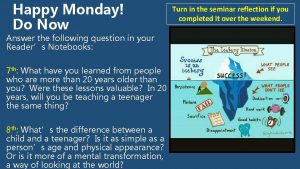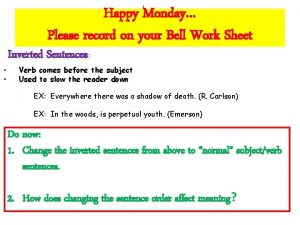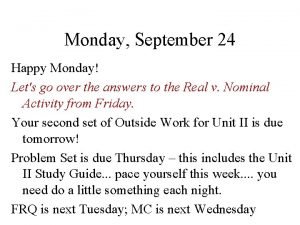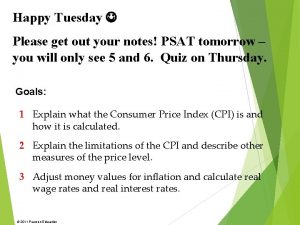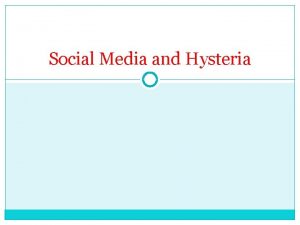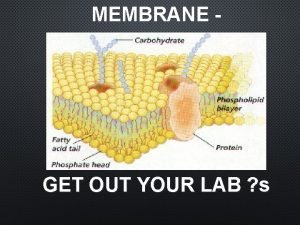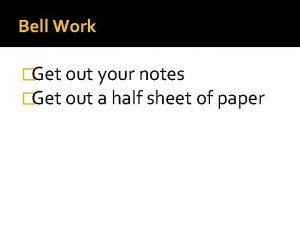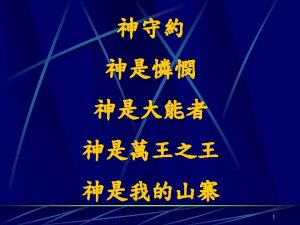Happy Monday Please get out your Chapter 24



































- Slides: 35

Happy Monday Please get out your Chapter 24 Flashcards – get ready to grade. We will be discussing Gross Domestic Product today – have your notes ready. HW: Read chapter 25 (there are no FCs to complete, but the reading is fair game for your Unit II Exam)

GDP DEFINED Gross Domestic Product (GDP): The market value of all the final goods and services produced within a country in a given time period, usually a year. Think of GDP as “flow” concept – like a water gauge measures the amount of water than flows through pipes in an hour, GDP measures the flow of the market value of production through an economies factories and shops each year. Intermediate good or service: good or service purchased for resale or used as a component of a final good or service. (These don’t count in GDP) Final good or service is a good or service that is produced for its final user (not as a component of another good or service) Example: The whole-sale distributor sells steak to Outback and then Outback sells to their customers. The final purchase price of steak by the patron is what is counted as cost…

Let’s make sure we have this…

GDP, CONT’D Market Value/Value Produced: We use market prices to determine value of production. Market determines the weights. What is Produced: only final goods and services are computed into the GDP Where Produced: only products produced within a nation’s borders When Produced: over a specified period of time, i. e. year or quarter.

The Four Sectors of GDP Economists measure GDP by totaling the money spent on the four sectors Consumer Sector Investment Sector Government Sector Net Exports

FOUR SECTORS, CONT’D Consumer Sector -Consumption (C): Expenditures/Spending by personal households on consumption goods and services for their direct use. Accounts for approx. 2/3 of GDP. Examples: new cars, HDTV’s, food, clothing, legal services, gas, visits to the orthodontist to get your grill straight, etc. Investment Sector -Investment (I): purchase of new capital goods and additions to inventories – these purchases enhance our abilities to provide more consumer benefits in the future. Examples: tools, instruments, machines, buildings, and other constructions

FOUR SECTORS CONT’D. Government Expenditures (G): the expenditure by all levels of government on goods and services. Ex. parks, highways, schools, national defense, law enforcement, etc. Net Exports (X-M or Xn): value of exports (X) of goods and services minus the value of imports (M) of goods and services. (Net Exports = Total Exports – Total Imports) Exports: goods that are produced in the US and sold to the rest of the world. Imports: goods that are foreign-produced and purchased by households and firms in the US

DOES NOT COUNT IN GDP Second hand sales, garage sales, flea market, black market, illegal transactions, i. e. used cars, street pharmaceuticals, bootleg DVDs Financial Transactions: 1. Public Transfer Payments – welfare, social security, veterans’ payment. 2. Private Transfer Payments – birthday money, graduation payment 3. Financial Assets - bonds and stocks, they are making loans, not buying goods and services. Nothing is created or produced for these transactions.

DOES IT COUNT TOWARDS GDP? If it is made with American labor on American soil it is U. S. GDP Used car bought from Pinky Ice in Colorado Tires sold to Ford Motor Company from Firestone in Cleveland, OH. Japanese Toyota truck factory in Tennessee. Ford Car factory in Mexico.

DOES IT COUNT PRACTICE Take a few moments and see if you can determine which of these scenarios would factor into the GDP calculation…. You have 5 minutes – work with some seated near you and be ready to justify your decisions!

Happy Tuesday Please get out your Unit II GDP Outside Work (p. 69 -73) – get ready to grade. We will continue discussing Gross Domestic Product today – have your notes ready. HW: Read Chapter 26 and begin flashcards – due Monday. Unit II Inflation Outside Work is Due Tuesday

Happy Tuesday Supply Quiz Today – be sure you know those determinants… Current events presentations after quiz… HW: Begin preparing for Supply, Demand Equilibrium Test…

EXPENDITURE APPROACH The Expenditure Approach: Measures GDP by using data on consumption expenditure, investment, government expenditure on goods and services, and net exports. Write this down: GDP = C + I + G + Xn Because firms pay out everything they receive as incomes to the factors of production, total expenditure equals total income. In Y other words Expenditures = Income = Y = GDP = C+ I + G + Xn

MEASURING U. S. GDP

GDP, INCOME, AND EXPENDITURE The figure shows the circular flow of income and expenditure. The table shows the U. S. data for 2009.

INCOME APPROACH Measures GDP by summing the incomes that firms pay households for the factors of production they hire. The U. S. National Income and Product Account divide incomes into two big categories: (1) WAGES (2) INTEREST, RENT, AND PROFITS Wages: the payment for labor services Interest, Rent, and Profits: the sum of the incomes earned by capital, land, and entrepreneurship. Write this down: Wages + (Rents + Interest + Profits) + Statistical Discrepancy (Adjustment)= GDP Statistical discrepancy is the discrepancy between the expenditure approach and income approach estimates of GDP, calculated as the GDP expenditure total minus the GDP income total.

MEASURING U. S. GDP – Income Approach

GROSS NATIONAL PRODUCT Gross national product or GNP is the market value of all the final goods and services produced anywhere in the world in a given time period by the factors of production supplied by residents of the country. Largest measure of a nation’s income. Ford factory in Mexico does count for GNP. French tire company in S. C. does not count U. S. GNP = U. S. GDP + Net factor income from abroad (payment that Americans receive from outside of the U. S - payments made to foreign-owned resources in the U. S. )

DISPOSABLE PERSONAL INCOME & PERSONAL INCOME Consumption expenditure is one of the largest components of aggregate expenditure and one of the main influences on it is disposable personal income. Disposable personal income is the income received by households minus personal income taxes paid. DI = PI – Taxes What can you do with DI?

What happens to GDP? GDP = C + I + G+ Xn 10/12/2012 - Labor Department announced 30, 000 drop in Initial Claims for Unemployment Insurance The lowest number of claims since Feb 2008 10/15/2012 – “C” increased by 1. 1% Projected increase was. 2%

Are you Keepin’ It Real, Son? ! Think about the following questions while watching Mr. Clifford drop knowledge: What is the difference between Nominal and Real Values? How does this impact the way we evaluate our economy? What is meant by a base year? What are some negatives of the GDP calculation?

Recap What is the difference between Nominal and Real Values? How does this impact the way we evaluate our economy? What is meant by a base year? What are some negatives of the GDP calculation?

Real vs. Nominal GDP Real GDP is the value of the final goods and services produced in a given year expressed in the prices of the base year. Nominal GDP is the value of the final goods and services produced in a given year expressed in the prices of that same year.

Calculating Real GDP The goal of calculating real GDP is to measure the extent to which total production has increased Real GDP removes the influence of price changes from the nominal GDP numbers. We will use two different years: 2005 and 2010 To find nominal GDP multiply the quantities of each item produced by the price level of that year.

Nominal GDP in 2005 is $100 million. Nominal GDP in 2010 is $300 million.

CALCULATING, cont’d Nominal GDP is 3 x greater in 2010 than in 2005. But, how much has the quantity of goods and services increased. The increase in real GDP will tell by how much the quantity of good and services has increased. To calculate real GDP in 2010 multiply the quantities produced in 2010 by the price in 2005 and the sum these expenditures to find real GDP in 2010.

Real GDP in 2005 is $100 million. Real GDP in 2010 is $160 million— only 1. 6 times real GDP in 2005.

Use and Limits of Real GDP We use Real GDP for three main purposes: (1) to compare standard of living over time (2) track the business cycle (3) compare standard of living among countries To compare living standards we calculate real GDP per capita—real GDP divided by the population. That gives us our real GDP person. To compare living standards across countries, we must convert real GDP into a common currency and common set of prices, called purchasing power parity (equivalent).

Standard of Living, cont’d The following things are not included in real GDP, yet impact standard of living. Health and Life Expectancy: good health does not directly show up in real GDP Political Freedom and Social Justice: political freedoms and social freedoms and justice are not included in real GDP The following goods and services are omitted from real GDP: household production, leisure time, environmental quality, underground production

Happy Wednesday AP You will need your notes and an additional sheet of paper and something to write with today… GDP Quiz tomorrow… Honors Get out your Equilibrium Practice sheet HW: Begin preparing for Supply, Demand Equilibrium Test…

USES OF REAL GDP – BUSINESS CYCLE Fluctuations in the pace of expansion of real GDP is called the business cycle. The business cycle is a periodic irregular up-and down movement of total production and other measure of economic activity. The four stages of a business cycle are expansion, peak, recession/contraction, and trough.

Business Cycle Business cycles begin with growth, or an upward trend in the economy. This growth leads to a peak or boom Peak or Boom: period of economic prosperity and growth. Eventually economy levels off and then begins to decline. Contraction (Slowdown): When the GDP or economy begins its decline. Business activity begins to slow down. Recession: any period of two or more quarters (6 months) during which real GDP does not grow.

Business Cycle, Cont’d At some point the economy will hit a trough, lowest part of the business cycle. The downward movement of economy levels off. Recovery/Expansion (Growth): After the cycle hits the trough, it enters into this stage of the cycle in which economic activity slowly begins to increase.

Causes of Business Fluctuations Four main forces are linked to business fluctuations: 1. Business Investment: When businesses predict an up tick in the economy: They will increase capital investment 2. Government Activity: affects business growth in two major ways: through its policies on taxing, and through its control over business activity in the form of regulation. Increases in either restricts growth. •

Causes, cont’d. 3. External Forces: Factors outside a nation’s economy also influence the business cycle. Ex. War, natural and environmental disasters, availability of natural resources or raw materials (oil). 4. Psychological Factors: People’s reactions to events can also cause business fluctuations. Ex. Sept 11. – airline ticket sales plummeted
 You're my kryptonite one direction
You're my kryptonite one direction Get into/out of
Get into/out of Were you happy yesterday
Were you happy yesterday Econmovies 3 monsters inc. answer key
Econmovies 3 monsters inc. answer key Happy monday quiz
Happy monday quiz Sit2play down
Sit2play down Happy monday answer
Happy monday answer Fake monday
Fake monday Happy monday afternoon images
Happy monday afternoon images Good morning happy november
Good morning happy november Happy november monday
Happy november monday Happy monday november 1st
Happy monday november 1st Happy wednesday
Happy wednesday Happy monday jr password
Happy monday jr password December morning message
December morning message Happy monday response
Happy monday response Happy monday answer key
Happy monday answer key Happy monday quiz
Happy monday quiz Happy monday hope you had a great weekend
Happy monday hope you had a great weekend Jimmy and eric were huddled by the tire swing
Jimmy and eric were huddled by the tire swing Econmovies episode 6 worksheet answers
Econmovies episode 6 worksheet answers Happy monday welcome back
Happy monday welcome back Will you please be quiet please summary
Will you please be quiet please summary Sad happy bored
Sad happy bored Sad smiley
Sad smiley Happy happy sad sad angry angry
Happy happy sad sad angry angry Happy feet orthotics
Happy feet orthotics Please get ready
Please get ready Please get ready
Please get ready Put your right foot in put your right foot out
Put your right foot in put your right foot out Get up get moving quiz
Get up get moving quiz Get up get moving quiz
Get up get moving quiz Get up get moving quiz
Get up get moving quiz Repetition pseudocode
Repetition pseudocode Get focused get results
Get focused get results Get up get moving quiz
Get up get moving quiz






